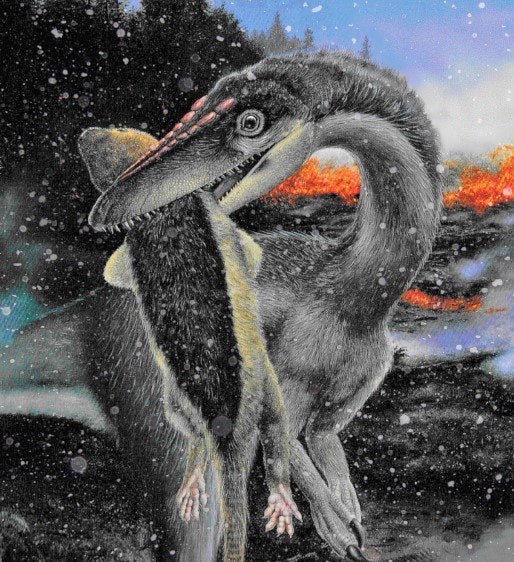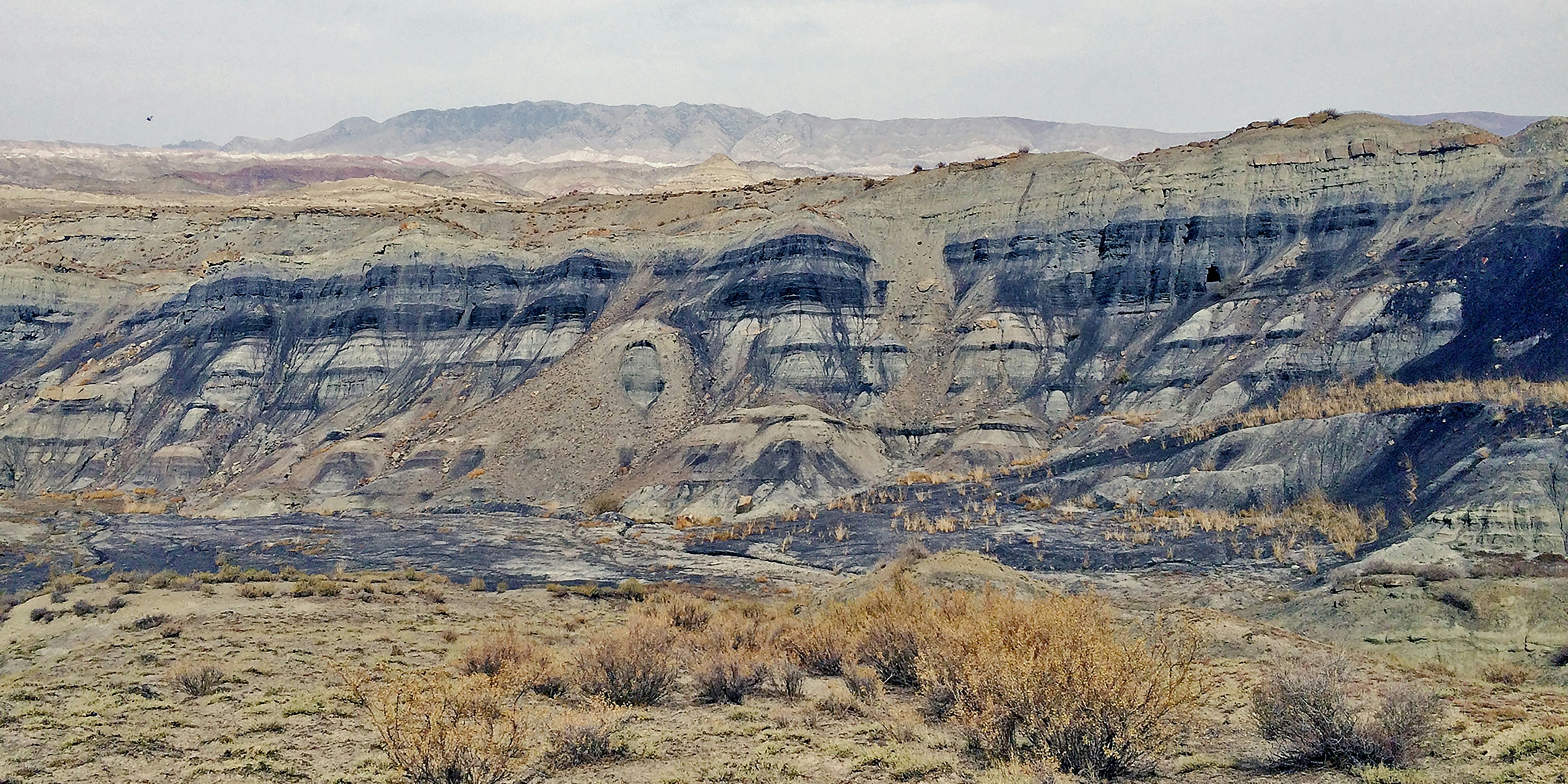
Dinosaurs are often depicted as dwelling in tropical climes. Now, a new study published online July 1 in the journal Science Advances suggests a number of the ancient reptiles may have endured freezing winters in the Arctic, potentially with the help of feather-like coverings. Indeed, this ability to survive the cold may have helped dinosaurs outlast their early rivals and come to dominate the world for roughly 135 million years.
HERE'S THE BACKGROUND — Dinosaurs are thought to have first appeared during the Triassic Period about 231 million years ago when most of the planet's land was still fused together in one giant supercontinent dubbed Pangaea. Ultimately, they came to spread across the globe, with the age of dinosaurs only ending about 66 million years ago.
Previous research suggested dinosaurs arose in temperate southerly latitudes and made it to the far north of Pangaea about 214 million years ago. However, until about 202 million years ago, dinosaurs were relatively minor players on the global stage. Instead, Earth's tropical and subtropical regions were dominated by other reptiles, including pseudosuchians, the group that includes crocodilians.
Then came the end of the Triassic and the start of the Jurassic, which saw a mass extinction, killing off more than three-quarters of all species on the planet, including all sizable reptiles. Some animals living in burrows, such as turtles, made it through, as did a few early mammals.
It remains unclear exactly what happened during this end-Triassic mass extinction. However, many scientists connect it to a series of gigantic volcanic eruptions that could have lasted centuries at a time. This disastrous era saw Pangaea begin to split apart, opening what is now the Atlantic Ocean and splitting what are now the Americas from Europe, Africa, and Asia.
During the Triassic, and for most of the Jurassic, atmospheric concentrations of the global warming gas carbon dioxide ranged at or more than 2,000 parts per million — five times today's levels. The eruptions during the end-Triassic mass extinction would have caused atmospheric carbon dioxide to skyrocket beyond these already high levels, causing deadly heat waves on land and turning ocean waters too acidic for many creatures to survive.
This cataclysm also saw the dinosaurs emerge as major players, once the other reptiles that until then ruled the planet died off. But why dinosaurs thrived when their competitors died has long been a mystery.
WHAT DID THE SCIENTISTS DO? — In the new study, researchers examined recent excavations in the remote desert of northwest China's Junggar Basin. They focused on fine-grained sandstone and siltstone formations left by mud in shallow ancient lake bottoms starting roughly 206 million years ago during the late Triassic, through the mass extinction and beyond. Back then, the area lay at roughly 71 degrees north, well above the Arctic Circle.
WHAT DID THEY FIND? — The scientists discovered footprints showing dinosaurs walked along the shorelines at the site. Moreover, in the lakes themselves, the researchers found many pebbles up to about 0.6 inches (1.5 centimeters) in diameter. Far from any apparent shoreline, the presence of these pebbles within the normally fine sediments was a mystery.
The most plausible explanation is that they were ice-rafted debris, the researchers say. When ice forms on a coast during the winter, it may incorporate bits of underlying rock. When winter ends and the location warms, some of this ice may break off, drifting away into the neighboring water. When it melts, the rocks sink to the bottom, mixing with the ordinarily fine sediments.
"We are far from the first to suggest that there were polar dinosaurs," study lead author Paul Olsen, a geologist and paleontologist at Columbia University's Lamont-Doherty Earth Observatory in Palisades, New York, tells Inverse. "Evidence of polar dinosaurs has been accumulating for over a century. That itself is not new. However, evidence that they were living in areas with freezing winters has been scant to non-existent."
All in all, these findings suggest that dinosaurs roamed the area back when it was in the Arctic, even when they froze. "My mantra coming out of our work is 'dinosaurs are fundamentally cold-adapted animals,'" Olsen says.

HOW DID IT GET COLD? — Previous research suggested the late Triassic and early Jurassic marked one of only a few times in Earth's history when there was no evidence of ice caps at the poles. Indeed, some excavations have shown that forests grew all the way to the North Pole back then.
Some climate models had suggested temperatures could still drop below freezing in polar regions. However, there was no evidence the poles froze during this otherwise warm stretch of time. "There is a clear prejudice of many scientists that during the Age of Dinosaurs, it was warm everywhere," Olsen says.
Given these new findings, the researchers suggest the fiercest eruptions at the end of the Triassic might have spewed out sulfurous compounds that deflected so much sunlight, they repeatedly triggered cold snaps lasting a decade or more that overpowered high greenhouse-gas levels, with even the tropics potentially experiencing freezing conditions.
Olsen cautions "our evidence does not suggest that polar ice caps or glaciers were present, although they do not rule out transient ice sheets. It's even possible they might have developed during particularly unusual times, like maybe repeated and prolonged volcanic winters. But that is for future work."
HOW DINOSAURS SURVIVED THE COLD — To see why dinosaurs might have survived these cold snaps, one has only to look at the world's only surviving dinosaurs, birds.
Prior work has increasingly found that a number of groups of dinosaurs other than birds possessed feather-like coverings. This has led some researchers to speculate that such "protofeathers" may have arisen early in the dinosaur lineage, perhaps to serve as insulation during cold times, only later evolving a role in flight. The apparent lack of protofeathers or feathers in some dinosaurs may be related to them living in warm climates and their need to stay cool instead of warm, just as adult African elephants lack fur.
In addition, birds are warm-blooded. A recent study finds many dinosaurs, including Tyrannosaurus and Brontosaurus, may have been warm-blooded as well. This would have helped dinosaurs survive wintery times that killed off their scaly, cold-blooded rivals.
"Until their non-insulated competitors were wiped out, they could not expand into the low latitudes in a big way," Olsen says. Early dinosaurs may have survived this time living off polar forests until they could expand across the rest of the world, the scientists note.
WHAT'S NEXT? — The next step is for more scientists to hunt for more fossils in former Triassic-Jurassic polar areas like the Junggar Basin. "The paleo-polar regions should be the focus of intense study, because they are plausibly the cradle of dinosaur evolution," Olsen says.







